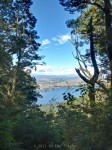Canon provides its cameras with software that is intended to cause baldness. ZoomBrowser EX is an insidious piece of software that plays around with the EXIF data on the camera, and PhotoStitch will join up your panoramic images like magic. Yeah, right. And then another 19 (nineteen) programs (!) install themselves on your machine, none of which have any use whatsoever.
Apart from the megalomanic scope of the software, it was the failure of PhotoStitch that started me on a journey into photography proper. PhotoStitch had decided that the perfectly good and level horizon of the Clinton Valley should, in fact, take on the shape of a horseshoe. Much shearing was done in order to smooth out this “wrinkle” and in the end I decided I needed new software.
What did turn up as freeware, was Hugin, which I can, in the meantime, recommend. For a while it looked like this program, too, would go the way of PhotoStitch, and occasionally Hugin requires a blank slate to start over again, but improvements to the software have been considerable in the last three years in terms of reliability and user friendliness. Not yet perfect by any means, but a lot more professional that Canon’s attempt.
The real goodies are, however, packed away in the \bin folder of the installation. These are various auxiliary programs such as align_image_stack.exe, enfuse.exe, autopano-sift-c.exe, exiftool.exe among others. And some of these come in little packages, “droplets”, that you will find on your desktop to drag files onto.
In order to blend the individual images of a panorama into a seamless whole, the software has to be able to map images to one another, combining information from two or more images. Now an exposure bracket is just an extreme version of a panorama, where all the images are of the same subject. Eric Krause’s droplets will do the work of combining different exposures to a single image. Basically this works by aligning the set of images to provide the best registration (i.e. “lining up”) and then “enfusing” them – think of it as averaging out all the images in the sequence, although the algorithm is slightly more sophisticated. Since the droplets (or better, the programs they control) can deal with sequences of any length (as far as your computer’s working memory suffices) this then provides the solution to my five-image bracketed sequence halfway up the Mackinnon Pass. Thank you very much indeed!
This opens up a very broad range of possibilities, even apart from exposure bracketing. Simply taking the same picture ten times and enfuse/aligning the resultant images is an excellent way of reducing sensor noise and thus very handy in astrophotography. Or when dealing with those pesky water vapour clouds at thermal areas.
But we are left with a problem or two. In order to get Hugin to work at its best, two common photographic distortions have to be dealt with, and dealt with in a major way: barrel/pincushion distortion and chromatic aberration.


